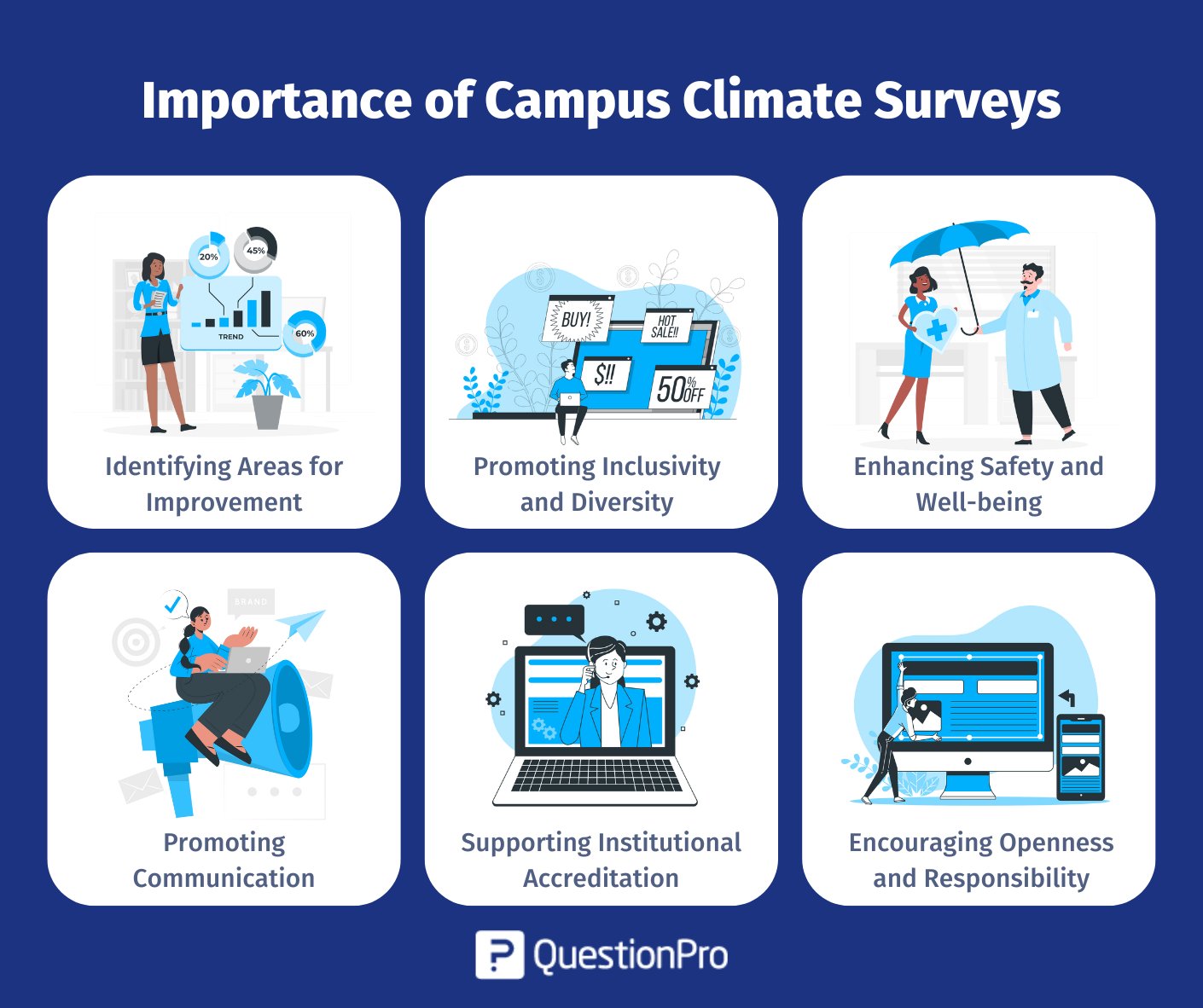
Understanding the campus atmosphere of students and employees is essential to ensuring long-term success. Campus climate surveys help educational institutions evaluate their diversity and inclusion efforts by collecting feedback from students, teachers, staff, and administrators.
Creating an inclusive campus involves more than appearances. To truly achieve this, you need to take the time to connect with students, teachers, and staff members. Building a genuinely inclusive campus climate requires getting to know the people who make up the community.
Institutions can understand and enhance inclusivity by conducting campus climate surveys. These surveys play a crucial role in creating a more supportive and equitable environment.
In this blog, we’ll look at campus climate surveys, why they’re important, how they operate, their advantages, recommended methods, and possible difficulties.
What are Campus Climate Surveys?
Campus Climate Surveys are effective tools that help senior leaders and campus administrators gain insights into students’ views and experiences. These surveys help identify strengths, highlight areas that can be improved, and track progress on important initiatives over time.
The campus climate survey effectively explains how undergraduate and graduate students feel about their overall experiences and diversity and inclusion at the university. The survey covers various aspects, such as:
- Campus life.
- Classes.
- Student services.
- Accessibility.
- Relationships.
- Cultural involvement.
- Other campus activities.
The survey also asks students about their personal experiences that may have shaped their views on diversity. It also seeks their opinions on diversity and the university’s efforts to promote it on campus.
The findings from these surveys can help improve policies, higher education & student learning programs, and other efforts to boost the well-being and success of people in the academic community.
Importance of Campus Climate Surveys
A campus climate survey can help universities understand what influences the experiences and views of people from different backgrounds on campus. This information creates a welcoming and respectful environment where everyone feels safe and valued.
Campus institutions can enhance the well-being and experiences of their community members by gathering and studying data on different aspects of campus life to make informed decisions. Here are some key reasons why these surveys are important:

1. Identifying Areas for Improvement
The campus climate survey offers:
- Structured Input: Provides a systematic approach to gathering student, faculty, and staff feedback.
- Identifies Areas for Enhancement: Pinpoints specific areas needing improvement in diversity, inclusiveness, safety, and overall well-being.
- Informs Decision-Making: Guides decisions on policies and initiatives based on comprehensive data.
- Promotes Inclusivity and Safety: Aims to create a more inclusive and safer campus environment.
- Engages Campus Community: Encourages participation from all campus community members to contribute to a positive climate.
2. Promoting Inclusivity and Diversity
Surveys examining the experiences of individuals from various backgrounds help institutions understand the specific difficulties different groups face. This understanding is crucial for establishing policies and initiatives that support inclusivity and diversity on campus.
3. Enhancing Safety and Well-being
Keeping the university and college campuses safe is crucial, and by conducting climate surveys, we can identify any worries about safety and well-being. This data helps institutions respond quickly, implement safety measures, and offer support services to ensure a secure environment.
4. Promoting Communication
Campus climate surveys help:
- Initiate crucial discussions: Facilitate dialogue about the campus experience among students, faculty, and staff.
- Provide structured expression: Offer a formal avenue for individuals to articulate their perspectives and concerns.
- Promote open communication: Encourage transparent communication to foster understanding and collaboration.
- Supportive environment: Aim to cultivate a more supportive and cooperative campus environment.
5. Supporting Institutional Accreditation
Nowadays, organizations that accredit educational institutions look at the overall campus atmosphere when assessing how well an institution performs. By conducting surveys and working to resolve any problems that come up, academic institutions can improve their chances of getting accredited.
6. Encouraging Openness and Responsibility
When a school conducts surveys about its campus environment, it shows that it is committed to being open. Recognizing areas that need improvement and actually doing something about them, using the survey findings, helps create a culture of responsibility. This dedication builds trust within the school community.
Challenges of Conducting a Campus Climate Survey
A campus climate survey provides significant information but presents many challenges that institutions must overcome. Here are some common difficulties faced when conducting these surveys:
- Low Response Rates: Getting many people to participate is hard. Students, teachers, and staff can be too busy. They can be unsure if the survey matters or worried their answers won’t remain private.
- Selection Bias: The ones who do the survey may not represent everyone on campus, which makes the survey results a bit one-sided.
- Sensitive Nature of Questions: Some questions about discrimination, harassment, sexual orientation, or personal stuff may make people uneasy, which could affect how truthful their answers are.
- Survey Fatigue: There are often a lot of surveys on campuses. Respondents may experience survey fatigue and lose interest and thoughtful engagement.
- Ensuring Honest and Accurate Responses: It’s a challenge for schools to make sure people give honest and accurate answers to the survey. Keeping responses private is super important to get honest feedback and reliable results.
Best Practices for Conducting a Campus Climate Survey
Conducting a campus climate survey requires careful planning and implementation to ensure meaningful and actionable results. Here are some best practices to consider:
- Clearly define your survey objectives: Clearly express what you want to learn or accomplish with the survey data.
- Ask culturally sensitive questions: Make sure your survey questions respect and include the diverse backgrounds and experiences of the campus community.
- Use different question types: Mix in both closed-ended (quantitative) and open-ended (qualitative) questions to get a well-rounded view of the campus atmosphere.
- Pick the right time: Choose a time for the survey when the campus community is available and open to participating, avoiding high-stress periods like exam weeks.
- Test the survey with a small group: Before launching the complete survey, test it with a small group to catch any issues with questions, wording, or format. Make adjustments based on feedback.
- Share results and take action: Inform the campus community about the survey findings, emphasizing important discoveries and planned improvements. Show a dedication to addressing concerns and making positive changes.
How QuestionPro Can Help for Campus Climate Survey
QuestionPro can be highly effective for conducting a campus climate survey. Here are some key ways it can help:

1. Affordable Enterprise Research Software
QuestionPro offers an Academic license that provides top-tier survey and research software at a budget-friendly price. We understand the challenges of limited budgets and the need for a comprehensive solution. With QuestionPro, you get:
- Fixed pricing for up to 5 years
- No extra cost for advanced features
- Educational discounts for audience projects
2. Comprehensive Survey Tools for Universities and Colleges
Whether you need a simple survey tool or a collaborative research solution, our Academic licenses give you access to the same high-quality features our Enterprise clients use. Key features include:
- Advanced logic and workflows for smarter surveys
- Trusted by over 5000 universities and colleges and over 1 million students
- Support for multi-admin roles
3. User-Friendly Experience
QuestionPro is designed to be intuitive and scalable, making it easy to create, send, and analyze surveys quickly. Our platform also includes powerful analytics tools to help you visualize your data. Key benefits include:
- Collaboration across universities
- Quantitative and qualitative reporting
- Data analytics and offline survey capabilities
4. Easy Migration, Training, and Support
Transitioning to QuestionPro is seamless, with support for migrating data from other survey software. We offer regular training and webinars to help you maximize your survey-building skills. Our support includes:
- Easy migration from Qualtrics, SurveyGizmo, and Survey Monkey
- 24/7 support with dedicated account managers
- Weekly free training sessions and monthly academic webinars
Conclusion
Creating a friendly, safe, and inclusive campus atmosphere requires conducting important climate surveys. These surveys provide valuable insights that can help universities make better decisions and improve campus life.
The significance of these surveys is immeasurable. Institutions must be mindful of challenges and embrace best practices to effectively use these surveys for advancing diversity, equity, and inclusion on campus.
An essential part of building a highly welcoming and supportive community is for institutions to regularly include a campus climate survey in their ongoing efforts to improve the campus environment.
QuestionPro is an online survey and research platform for creating, sharing, and studying surveys. It can help you gather important information from participants, making it handy for different survey types, like campus climate surveys.
QuestionPro offers a wide range of survey templates, including a campus climate survey template. Select a template that matches your goals, or build a survey from the beginning.
Frequently Asked Questions (FAQs)
Campus Climate Surveys are effective tools that help senior leaders and campus administrators gain insights into students’ views and experiences.
The five key elements of school climate typically include:
1. Safety
2. Relationships
3. Teaching and Learning
4. Institutional Environment
5. School Connectedness
The goal of a climate survey is to:
1. Assess the current environment: Understand the perceptions and experiences of students, staff, and faculty.
2. Identify strengths and weaknesses: Highlight areas of success and areas needing improvement.
3. Enhance inclusivity and safety: Ensure all members have a safe, supportive, and inclusive atmosphere.
4. Inform policy and decision-making: Provide data to guide policies, programs, and initiatives.
5. Foster community engagement: Encourage participation and input from the entire school community.







